Ranunculus ficaria L. - Lesser Celandine
Phylum: Magnoliophyta - Class: Equisetopsida - Order: Ranunculales - Family: Ranunculaceae
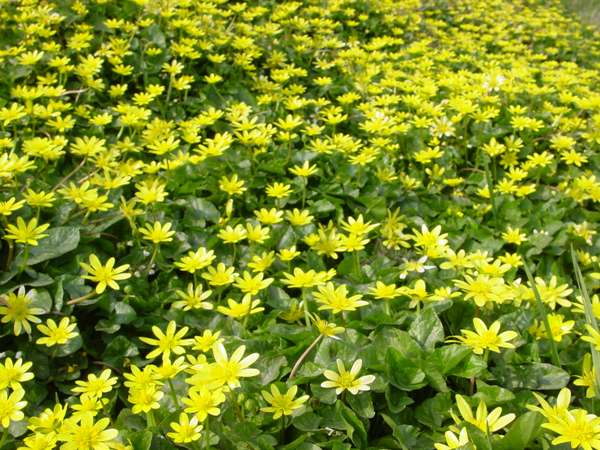
When people talk about celandines, it is tothe Lesser Celandine, a butter-yellow spring flower, that they are invariably referring.
Description
Instantly recognisable by its bright glossy yellow flowers, Ranunculus ficaria has a variable number of petals.
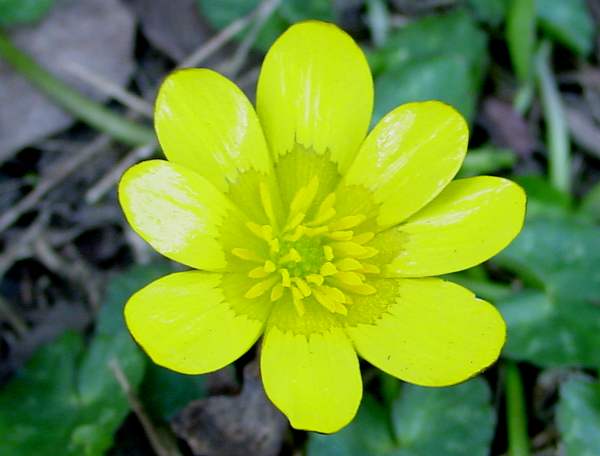
While eight to ten petals are typical, we have found individual Lesser Celandine flowers with as many as 13 petals. (Petal counting is a sad hobby!) Each flower stalk bears a single flower,
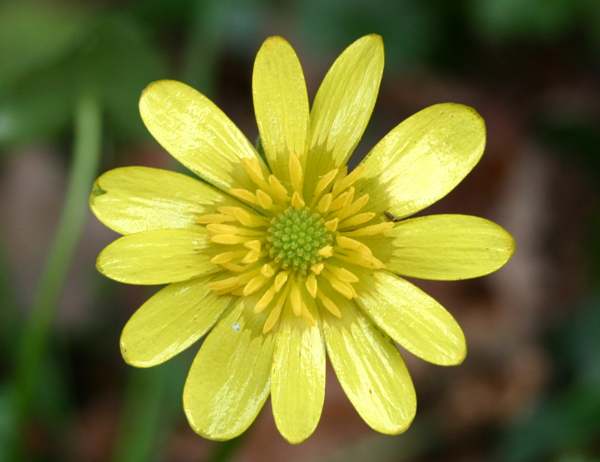
The leaves are heart shaped, veined and and usually patterned in light and dark green.
Pollination
Celandines are pollinated by insects, and in early springtime many of these are small flies of the order Diptera - two-winged flies sometimes referred to as the 'true flies'.
As with other members of the buttercup family, the green seeds are clustered in a spiky ball.
Distribution
Lesser Celandine is a very common and widespread spring wildflower throughout Britain and Ireland.
This plants is also found across most temperate regions of of Europe and Asia. In North America Ranunculus ficaria is an introduced alien species and has become a nuisance invasive weed.
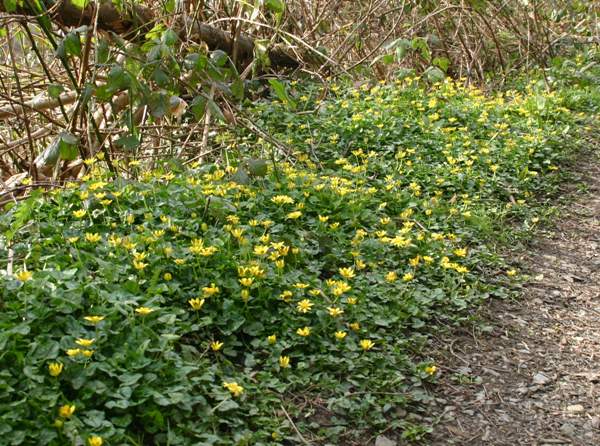
Habitat
Lesser Celandines have a preference for the edges of damp woodland, hedgerows, ditches andriverbanks, but shady lawns that are not treated with weed-and-feed chemicals can also sport displays of celandines in springtime.
Blooming Times
It always cheers us up tremendously to see the first displays of Lesser Celandines on bright sunny days; It means that spring is on the way.
In Britain and Ireland as early as February, and in sheltered locations sometimes even before the end of January, Lesser Celandines can usually be seen in flower from March to early June.
Taxonomic history
This lovely wildflower was described scientifically by the Swedish naturalist Carl Linnaeus, in the first edition of his Species Plantarum of 1753.
Linnaeus gave the Lesser Celandine the binomial name Ranunculus ficaria by which it is most generally known todaybut botaniosts generally recognise two varieties of Lesser Celandines. The nominate type is Ranunculus ficaria var. ficaria, while a variety that produces bulbils at its leaf axils is given the scientific name Ranunculus ficaria var, bulbifer.
Uses
One of the other common names of Ranunculus ficaria is Pilewort, which comes fromthe appearance (like piles or Haemorrhoids) of the knobbly tubers from which these plants grow. elandine, pilewort, also derives from the appearance of these knobbly tubers. In line with the 'doctrine of signatures', whereby plants were used to treat ailments affecting parts of the body that they resembled, Ranunculus ficaria was used to treat haemorrhoids.
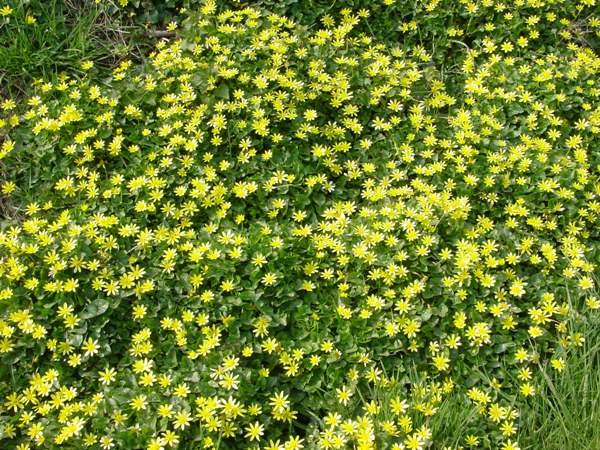
Etymology
The common name Celandine may come from the Latin chelīdonius, via 13th century English celydon. Chelīdonius comes from the Greek khelidōn, meaning a Swallow. The flowering of the Lesser Celandine was thought to coincide with the arrival in Northern Europe of swallows from their southern wintering grounds in South Africa, southern Asia and India. The theory was that when the flowers faded the swallows would also depart, although in our experience there are usually plenty of Swallows remaining in Britain long after the last of the Lesser Celandines has faded and died.
The genus name Ranunculus comes from the Latin rana, meaning frog, while the suffix -culus indicates the diminutive form - hence Ranunculus means 'little frog'. The most likely explanation is that both frogs and Lesser Celandines are usually found in damp places. In the USA this plant is generally referred to as the Fig Buttercup, a reference to the root structure of the plant, whose specific epithet ficaria means 'of a fig'.
Similar Species
Marsh-marigold Caltha palustris has larger flowers with overlapping petals.
Despite its common name, the GreaterCelandine Chelidonium majus is not a close relative and it flowers much later in the year.
Reference Sources
O'Reilly, Pat, and Parker, Sue. (2005). Wonderful Wildflowers of Wales, Volume I - Woodland and Waysides. First Nature. ISBN 0-9549554-1-2
Marsden-Jones, E. M. (1935). Ranunculus ficaria Linn.: life-history and pollination. The Journal of the Linnean Society of London (Botany) 50: 39-55.
Marsden-Jones, E. M. (1937). Pollination.of Ranunculus ficaria L. by insects. The Journal of Botany (London) 75: 133-14l.
Hudson, W. (1762). Flora Anglica. London.
Mabey, Richard. (1996). Flora britannica; Chatto & Windus. ISBN 1856193772
Blamey, Marjorie & Grey-Wilson, Christopher. (1989). Flora of Britain and Northern Europe.
Preston, Pearman & Dines (2002) New Atlas of the British Flora. Oxford University Press.
Please Help Us: If you have found this information interesting and useful, please consider helping to keep First Nature online by making a small donation towards the web hosting and internet costs.
Any donations over and above the essential running costs will help support the conservation work of Plantlife, the Rivers Trust and charitable botanic gardens - as do author royalties and publisher proceeds from books by Pat and Sue.



